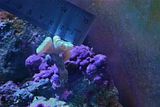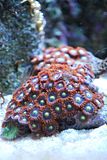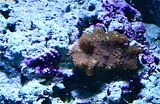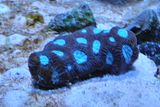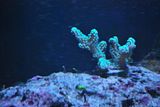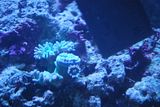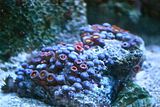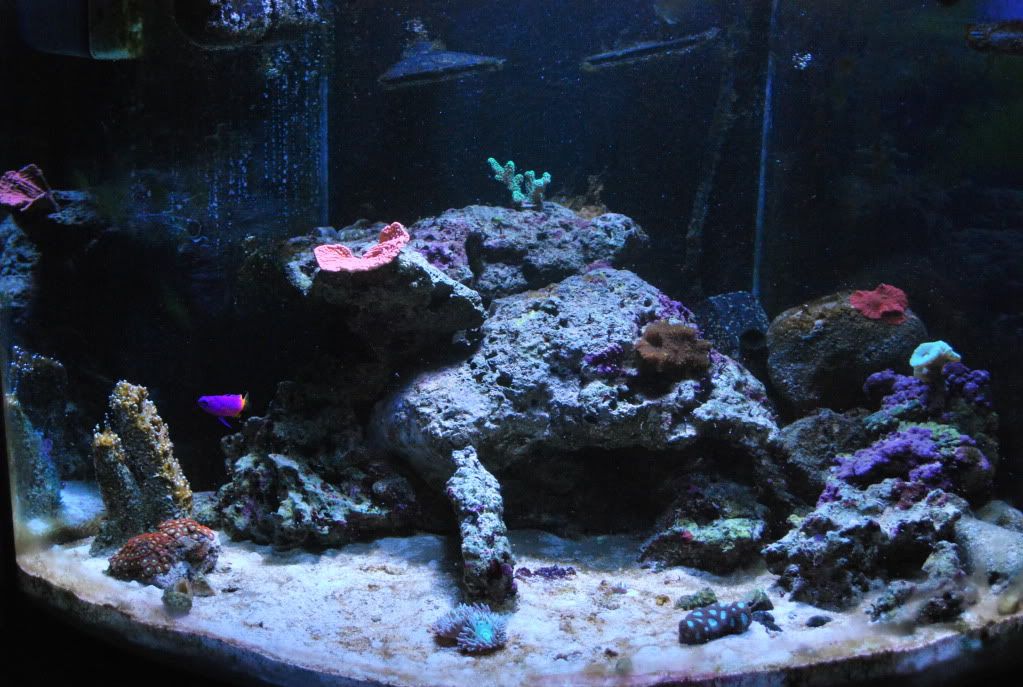1
Coral Carbon Crisis
Peak-to-Peak Charter School
April 10th, 2011 Michael McKibben
Abstract
What is the effect of carbonic acid on the reef ecosystem? The Hypothesis was When the average ph of a coral reef (8.1) drops by .1 every 4 days for 24 days, the following corals are predicted to begin the dieing process at these ph levels: SPS at 7.65, LPS at 7.6, but soft corals won’t die in this time frame.
The first week of the experiment the pH of the aquarium was put at a normal level of 8.1. During this period the pH of the aquarium, and average plankton per drop was tested three times a day. To test the average plankton per drop, a plankton net and microscope was used. The plankton was collected, and sucked up into a syringe. Ten drops from this syringe were placed on a Petri dish; next the plankton was counted in each drop using the microscope. These numbers were then added up, and divided by ten to get your average for that test. This routine was repeated for the rest of the experiment. On day 7 the pH was lowered to 8.0. From this point on the pH was dropped by .1 every four days until the corals began to show signs of death.
According to the data given corals began to show signs of stress at a pH of 7.9, and SPS corals begin to die at 7.6. Over all the average plankton per drop went up by about 10% by the end of the experiment. It can be assumed this is happening because the coral polyps were smaller, and didn’t consume as much plankton. The corals health is probably being affected by the pH, since it’s the only variable we changed during the duration of the experiment. The hypothesis was incorrect, it was predicted that the SPS corals would die at a pH of 7.65, the LPS at 7.6, and the Soft corals wouldn’t die at all. According to the data the SPS corals began to bleach at 7.61.
Table of Contents
1. Title Page
2. Abstract
3. Table of Contents
4. Review of Literature………………………………………………………………4
5. Statement of the Problem…………………………………………………………7
6. Hypothesis………………………………………………………………………...8
7. Procedures- Materials, Procedure, Variables/ Groups……………………………9
8. Results……………………………………………………………………………14
9. Interpretation of Data…………………………………………………………….15
10. Conclusion……………………………………………………………………….16
11. Feature Studies…………………………………………………………………...17
12. Acknowledgements……………………………………………………………....18
13. Works Cited……………………………………………………………………...19
Review of Literature
“Life on earth has evolved for more than 3.5 billion years with continual appearances
and extinctions” (Nilsen and FossÅ 95). Currently humans are playing a role in a mass extinction. When the average person hears this, climate change comes to mind. Climate change may still be a theory to some people. There is though, a little known, and proven disaster also happening. Ocean acidification is a huge problem. Carbon dioxide that humans produce is now being absorbed into the world’s oceans. The acid produced by the absorption of carbon dioxide into seawater is very destructive, but is it the cause of ocean acidification?
Carbonic acid (H2CO3) and the effects it has on coral reefs can be difficult to understand. There are many variables it can affect, but pH is the main one. Carbonic acid
is produced when CO2 comes in contact with water. This compound then lowers pH. The pH scale is a system humans use to measure the acidity of a substance. Neutral pH is 7.0, any less is acid, and anything more is a base. The natural pH of coral reefs is between 7.9 and 8.2, which gives an average of 8.1 at midday. Some argue that that pH change is caused by the alkalinity of the water. The proper amount of alkalinity helps corals build up their skeleton. The alkalinity on coral reefs is 2300 µmol/Kg, and changes by a maximum of 100 µmol/Kg throughout out the day. In order for the pH of the ocean to have swings between 7.9, and 8.2, the alkalinity would have to change by 1300 µmol/Kg, (McNeil 595). This proves that the pH change is caused by carbonic acid. According to NOAA the average pH on coral reefs will drop to 7.9 by 2050, and 7.8 by 2100. Don’t forget the pH change of -1.1, and +1 that occur through out the day. This gives a maximum drop to 7.79 in 2050, and 6.69 in 2100. That may not seem like much of a change, but it can spell disaster for corals.
“To dive or snorkel on a coral reef, or even see a film or photograph of on, is to be presented with a complex, apparently chaotic tableau of bizarre shapes and colors.” (Hunt 9). None of this would be possible without the corals. Corals can be classified into three main groups, LPS, SPS, and soft corals. Each group has it general qualities, but there are a few exceptions. By far the hardiest of the three are soft corals. This group is normally found in the bottom of mid areas of the reef. They are called soft corals because they lack a calcium carbonate skeleton that other corals have. Soft corals come in many shapes and forms, from small individual polyps, to large tree like structures. Most of them prefer strong water flow, and medium to low light. Three examples of these could be Protopalythoa sp., Atinodiscus sp., and Cladiella sp.
LPS (Large Polyp Stony) corals are a little more sensitive to water quality. They prefer medium to strong light, and moderate water flow. Some common species are Caultastrea Farcata, Favites sp., and Dancanopsmammia Axifuga. By far the most sensitive group is the SPS (Small Polyp Stony) corals; the slightest change in chemistry can set of a number of illnesses. SPS corals are commonly found in mats, plates, bowls, and branching structures. They are commonly found at the top of the reef where there is strong light, and water flow. Many people seem to mistake this group for rocks and step on them, with out realizing how much damage they’ve done. Three examples of SPS corals would be Montipora Capicornus, Seriatopora Guttatus, and Montipora Spongodes. This group is also the most effected by climate change; two-degree changes can set off bleaching. Ph, and alkalinity play a huge role in the hard coral family. They use alkaline, and calcium to build up their skeletons. pH can alter the rate they do this, thus making it harder for them to regenerate loss tissue. pH also effects plankton, a main source of nutrients for the corals. The food supplied by the Zooxanthellae doesn’t supply any nutrients, so it’s imperative that the corals get proper amounts of plankton.
It is known that we produce excessive amounts of CO2, and it’s known it can hurt the environment in many ways; why don’t we stop? It’s killing corals, and if there’s no coral there’s no fish. These marine ecosystems are important habitats, without them, coast lines get battered by waves more, millions of other species that rely on reefs will also die. Research has shown the predicted pH drop, but not if the corals will adapt to this Ph. There is evidence that shows that corrals will not adapt to a lower pH, but testing is needed in order to find the truth. For it was Alf Jacob Nilsen, and Svein A. FossÅ who said, “for our beloved children, it is you who shall inherit the world; isn’t it time we started to take care of it for the next generation.
Statement of the Problem
Ocean acidification is a huge problem. Millions of species are affected by it. Humans don’t know how long it will take for that pH to effect a reef ecosystem, or what pH level will do so. What is the effect of carbonic acid on the reef ecosystem?
Hypothesis
When the average ph of a coral reef (8.1) drops by .1 every 4 days for 24 days, the following corals are predicted to begin the dieing process at these ph levels: SPS at 7.65, LPS at 7.6, but soft corals won’t die in this time frame. Scientists predict lower pH will injure corals since lower pH can impact coral skeleton health. (NOAA web site refer) The specific pH levels predicted for this experiment are based on the observations of many aquarists as reported on public web sites and in books. (This experiment will not kill the coral, they will begin to show signs of extreme stress, then the aquariums pH will be raised back to a normal level. This will allow the corals to regenerate any lost tissue within a few months.)

